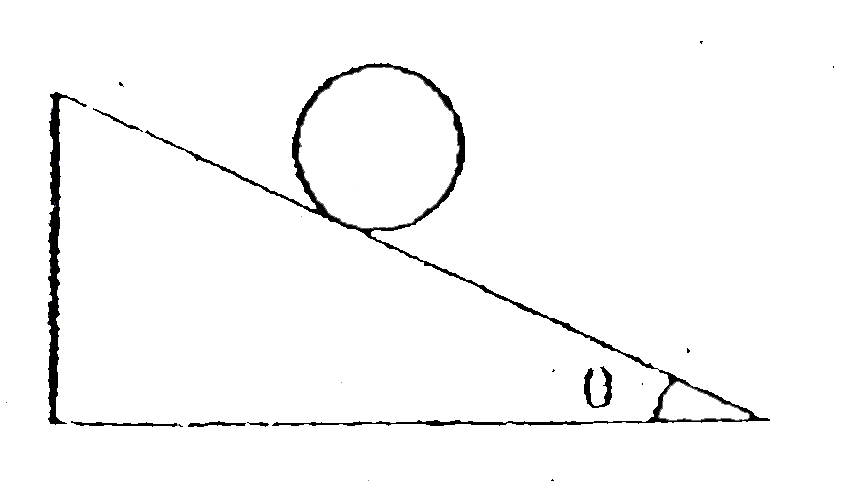A uniform ring rolls down an inclined plane without slipping. If it reaches the bottom of a speed of 2m/s, then calculate the height of the inclined plane (use g=10m/s2)
To solve the problem of a uniform ring rolling down an inclined plane without slipping, we can use the principle of conservation of mechanical energy. Here’s a step-by-step solution:
Step 1: Understand the Energy Conservation Principle
When the ring rolls down the inclined plane, its gravitational potential energy is converted into kinetic energy. The total mechanical energy at the top of the incline (potential energy) will equal the total mechanical energy at the bottom (kinetic energy).
Step 2: Write the Expression for Potential Energy
The gravitational potential energy (PE) at height h is given by:
PE=mgh
where:
- m = mass of the ring
- g = acceleration due to gravity (given as 10m/s2)
- h = height of the incline
Step 3: Write the Expression for Kinetic Energy
The kinetic energy (KE) at the bottom of the incline consists of two parts: translational kinetic energy and rotational kinetic energy. The total kinetic energy is given by:
KE=12mv2+12Iω2
For a uniform ring, the moment of inertia I about its center is:
I=mr2
The relationship between linear velocity v and angular velocity ω for rolling without slipping is:
ω=vr
Substituting I and ω into the kinetic energy equation gives:
KE=12mv2+12(mr2)(vr)2
This simplifies to:
KE=12mv2+12mv2=mv2
Step 4: Set Potential Energy Equal to Kinetic Energy
From the conservation of energy, we have:
mgh=mv2
We can cancel m from both sides (assuming m≠0):
gh=v2
Step 5: Solve for Height h
Rearranging the equation gives:
h=v2g
Substituting the given values v=2m/s and g=10m/s2:
h=(2)210=410=0.4m
Final Answer
The height of the inclined plane is:
h=0.4m
---
When the ring rolls down the inclined plane, its gravitational potential energy is converted into kinetic energy. The total mechanical energy at the top of the incline (potential energy) will equal the total mechanical energy at the bottom (kinetic energy).
The gravitational potential energy (PE) at height h is given by:
PE=mgh
where:
- m = mass of the ring
- g = acceleration due to gravity (given as 10m/s2)
- h = height of the incline
The kinetic energy (KE) at the bottom of the incline consists of two parts: translational kinetic energy and rotational kinetic energy. The total kinetic energy is given by:
KE=12mv2+12Iω2
For a uniform ring, the moment of inertia I about its center is:
I=mr2
The relationship between linear velocity v and angular velocity ω for rolling without slipping is:
ω=vr
Substituting I and ω into the kinetic energy equation gives:
KE=12mv2+12(mr2)(vr)2
This simplifies to:
KE=12mv2+12mv2=mv2
From the conservation of energy, we have:
mgh=mv2
We can cancel m from both sides (assuming m≠0):
gh=v2
Rearranging the equation gives:
h=v2g
Substituting the given values v=2m/s and g=10m/s2:
h=(2)210=410=0.4m
The height of the inclined plane is:
h=0.4m
Topper's Solved these Questions
- SYSTEM OF PARTICLES AND ROTATIONAL MOTIONBOOK - AAKASH INSTITUTE ENGLISHCHAPTER - SYSTEM OF PARTICLES AND ROTATIONAL MOTIONEXERCISE - Assignment (Section - J) Aakash Challengers Questions
13 Videos
- SEMICONDUCTOR ELECTRONICS: MATERIALS, DEVICES AND SIMPLE CIRCUITSBOOK - AAKASH INSTITUTE ENGLISHCHAPTER - SEMICONDUCTOR ELECTRONICS: MATERIALS, DEVICES AND SIMPLE CIRCUITSEXERCISE - Assignment (Section-D (Assertion and reason))
5 Videos
- TEST 1BOOK - AAKASH INSTITUTE ENGLISHCHAPTER - TEST 1EXERCISE - EXERCISE
21 Videos
Similar Questions
A solid sphere is rolling down an inclined plane without slipping of height 20 m. Calculate the maximum velocity with which it will reach the bottom of the plane (g=10m/s2)
View SolutionA solid sphere is rolling down an inclined plane without slipping of height 20 m. Calculate the maximum velocity with which it will reach the bottom of the plane (g=10m/s2)
View Solution
Knowledge Check
A solid cylinder of mass M and radius R rolls down an inclined plane without slipping. THE speed of its centre of mass when it reaches the bottom is
A√(2gh)B√4/3.ghC√3/4.ghD√(4g/h)
A solid cylinder rolls down an inclined plane of height 3m and reaches the bottom of plane with angular velocity of 2√2rad/s. The radius of cylinder must be [take g=10m/s2]
View SolutionA solid cylinder is rolling down the inclined plane without slipping. Which of the following is correct?

View SolutionThe M.I. of a solid cylinder about its axis is I. It is allowed to rool down an incline plane without slipping. If its angular velocity at the bottom be ω, then kinetic energy of rolling cylinder will be
View SolutionA ring starts to roll down the inclined plane of height h without slipping . The velocity when it reaches the ground is
View SolutionA thin uniform circular ring is rolling down an inclined plane of inclination 30∘ without slipping. Its linear acceleration along the inclined plane will be
View SolutionA thin uniform circular ring is rolling down an inclined plane of inclination 30∘ without slipping. Its linear acceleration along the inclined plane is :
View SolutionA thin uniform circular ring is rolling down an inclined plane of inclination 30∘ without slipping. Its linear acceleration along the inclined plane will be
View Solution